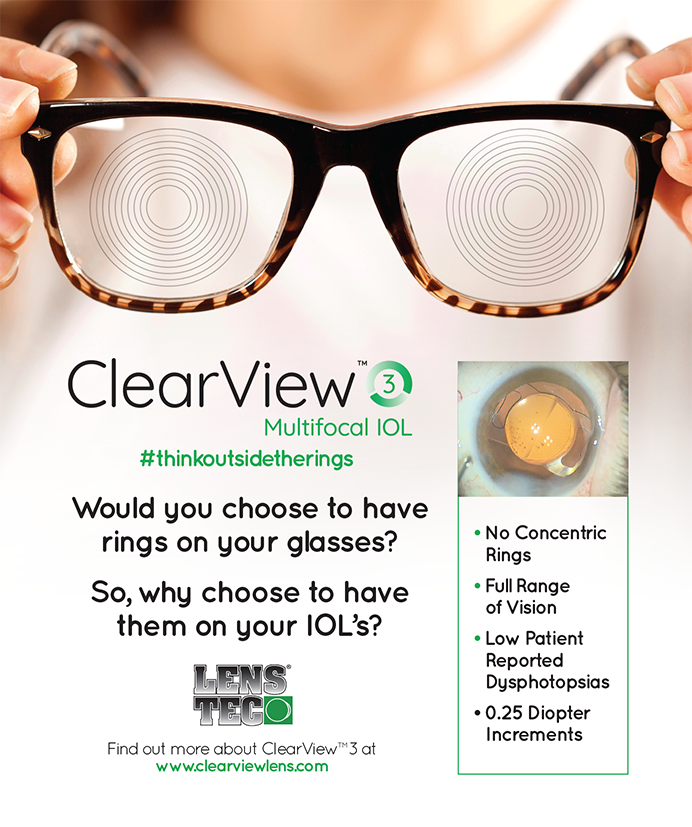Amniotic membrane (the innermost layer of membrane that surrounds the fetus in the womb and protects it from maternal insults) has been recognized for its role in wound healing for decades. Its use in ocular reconstruction dates to the 1940s when it was used for symblepharon surgical techniques. The tissue consists of a monolayer of epithelium, underlying basement membrane, and an avascular stromal matrix. Because amniotic membrane does not produce antigens of histocompatibility, host tissues do not reject it. Moreover, donor tissue is tested for transmissible infections such as HIV, hepatitis B and C, cytomegalovirus, syphilis, and toxoplasma. Amniotic membrane is preserved at -80ºC on nitrocellulose paper in a special medium. It comes in glass vials in sizes ranging from 1 X 1cm to 3 X 3cm (Figure 1). Amniotic membrane promotes epithelialization through many mechanisms. First, it acts as a substrate for the growth of corneal epithelial progenitor cells. Second, it facilitates the migration, adhesion, and cellular differentiation of epithelial cells. Amniotic membrane also prevents cell apoptosis,1 protease activity,2 inflammation, neovascularization,3 and scarring.4
SURGICAL TECHNIQUE
Every case should be handled differently. One general rule is to place the amniotic membrane epithelial side up and the mesenchymal side down to facilitate adherence. We typically initiate the procedure by removing the scar tissue and performing a superficial keratectomy if necessary. The amniotic membrane is draped over the denuded ocular surface and pulled taut. We use either 10–0 nylon or 10–0 Vicryl sutures (Ethicon Inc., Somerville, NJ) in an interrupted fashion to secure the membrane.
We have experimented with different types of placement. Inlays, where the amniotic membrane is slightly larger than the defect, allow for epithelialization to take place above them (Figure 2). Overlays—where the amniotic membrane is placed over the entire cornea, limbus, and perilimbus—allow for the epithelialization to occur beneath them (Figure 3). Filling a defect with multiple layers of amniotic membrane can also help close it. A combination of inlays and overlays to create a sandwich of amniotic membrane is another option.
We place a contact lens over the amniotic membrane to help it from becoming irritated and rubbing off. A partial tarsorrhaphy can serve the same purpose. We also use antibiotics, steroids, and lubrication postoperatively. The membrane lasts for several weeks. Sometimes, removing one layer of amniotic membrane becomes necessary in order to view the cornea and the rest of the eye. We should note that our experience has only been with fresh, frozen amniotic membrane. We have not worked with dehydrated membrane.
OUR EXPERIENCECase 1
At the Moran Eye Center, University of Utah, Salt Lake City, we have performed amniotic membrane transplantation on several patients over the last few months. In one case, we placed the transplant in order to close a herpetic ulcer that had melted the cornea by 50% in a paracentral area that was 3mm in diameter. Three layers of amniotic tissue used in a sandwich-type fashion closed the defect over the course of 2 months. The patient had an excellent recovery of visual acuity and exhibited only a mild, faint, residual scar in the involved area on follow-up.
Case 2
A patient was referred to us after she suffered a significant phaco burn at the corneal wound due to the dense nature of the nucleus. Her surgeon was unable to close the wound because the collagen tissue had shrunk. We closed the 3-mm, temporal, clear corneal incision with several interrupted sutures and then secured it with two layers of amniotic membrane over the top. This technique helped keep the incision closed and prevented the induction of large amounts of astigmatism, a typical problem with such burns (Figure 4).
Case 3
Another patient presented with a small, central corneal perforation associated with keratoconic hydrops. After our attempts at closing the opening with cyanoacrylate glue and contact lens placement were unsuccessful, we stopped the leakage by placing amniotic membrane. The tissue controlled the leakage and maintained the anterior chamber as the hydrops resolved during the next few weeks.
Case 4
Amniotic membrane transplantation can also help resolve persistent epithelial defects related to partial stem cell deficiency. In one of our patients, the defect was secondary to exposure and refractory to partial, temporal, permanent tarsorrhaphy and lubrication. The defect remained open, and eventually band keratopathy associated with chronic inflammation developed in this area. We used amniotic membrane transplantation to close the defect after removing the calcium with superficial keratectomy and ethylene diamine-tetra-acetate; we also placed a nasal, permanent tarsorrhaphy. During the next 3 weeks, the amniotic membrane disintegrated, and the area smoothly epithelialized without evidence of recurrent band keratopathy.
Case 5
A patient with Acanthamoeba keratitis who was being treated with antiparasitic medications suffered a persistent epithelial defect associated with inflammation, neovascularization, and scarring. The defect was unresponsive to surface treatment. After closing the defect with two layers of amniotic membrane, the cornea became less inflamed and vascularized, allowing for definitive treatment with a penetrating keratoplasty. At the time of penetrating keratoplasty, the donor was covered with a triple layer of amniotic membrane to help recover the ocular surface in this inflamed eye. This approach successfully prevented neovascularization and inflammation. Within 2 weeks postoperatively, we removed two layers of the amniotic membrane to better visualize the cornea.
Case 6
A patient with bilateral, large pterygia nasally and temporally lacked sufficient normal conjunctival tissue for autografts. We therefore used amniotic membrane in its place, and the patient has not had a recurrence during more than 4 months of follow-up.
Other indications for amniotic membrane transplantation are the treatment of ocular surface disease associated with symblepharon in Stevens-Johnson syndrome, chemical and thermal burns, painful bullous keratopathy, and noninfectious corneal ulcers.
POTENTIAL COMPLICATIONS
Overall, the rate of side effects is low for amniotic membrane transplantation. Some potential complications include dehiscence and disintegration of the membrane as well as ocular irritation and pain. Two limitations of amniotic membrane transplantation are the expense of the tissue and the time needed in the OR to handle the delicate membrane. In addition, amniotic membrane transplantation alone cannot treat patients with total stem cell deficiency; in our experience, a limbal stem cell transplant is necessary. Finally, placing multiple layers of amniotic membrane over the cornea can limit the surgeon's view at the slit lamp microscope.
CONCLUSION
We have found amniotic membrane transplantation to be effective in promoting corneal healing in our patients. The technique does not replace ocular surface rejuvenating methods such as lubrication, contact lenses, punctal plugs, tarsorrhaphy, and blepharitis treatment. Instead, it is an adjunctive treatment, the indications for which are expanding and gaining recognition.
Rajiv Kumar, MD, is a cornea and refractive fellow at the John A. Moran Eye Center, University of Utah, Salt Lake City. He states that he holds no financial interest in the products or companies mentioned herein. Dr. Kumar may be reached at (801) 585-3937; kumar.rajiv@hsc.utah.edu.
1. Bourdeau N, Sympson CJ, Werb Z, et al. Suppression of ICE and apoptosis in mammary epithelial cells by extracellular matrix. Science. 1995;267:891-893.
2. Na BK, Hwang JH, Kim JC, et al. Analysis of human amniotic membrane components as proteinase inhibitors for development of therapeutic agent of recalcitrant keratitis. Trophoblast Res. 1999;13:459-466.
3. Hao Y, Ma DH, Hwang DG, et al. Identification of antiangiogenic and anti-inflammatory proteins in human amniotic membrane. Cornea. 2000;19:348-352.
4. Lee SB, Li DQ, Tan DT, et al. Suppression of TGF-b signaling in both normal conjunctival fibroblast and pterygial body fibroblasts by amniotic membrane. Curr Eye Res. 2000;20:325-334.


